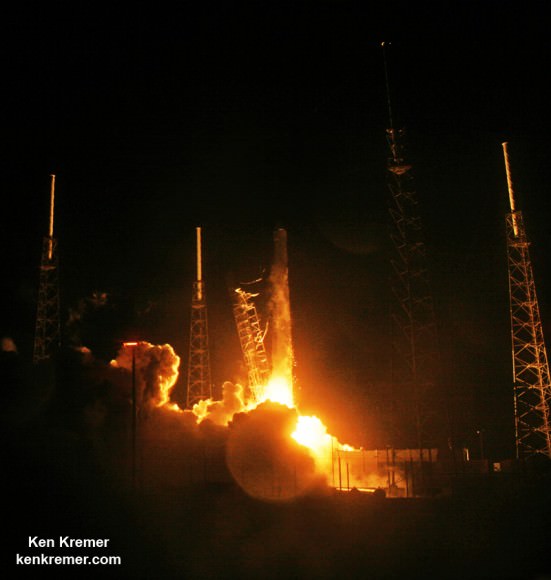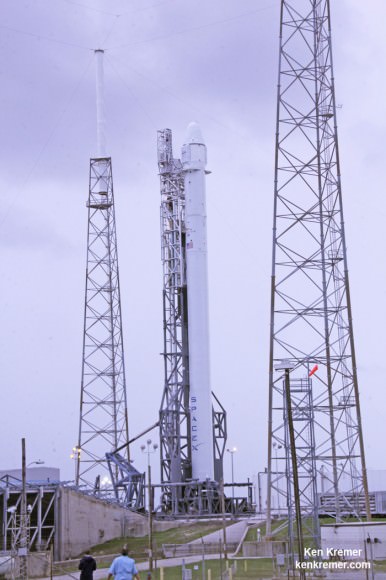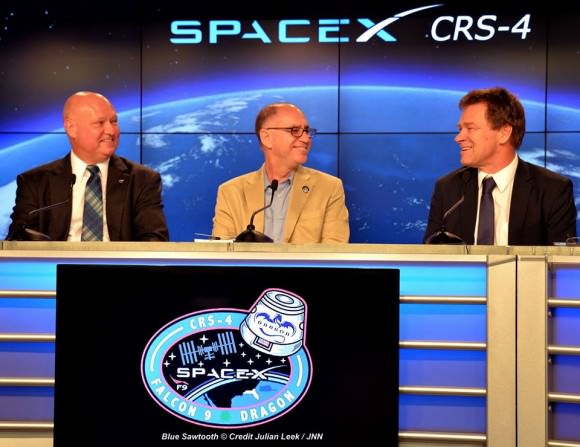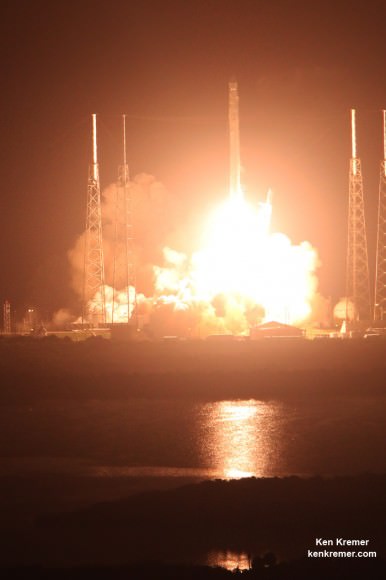KENNEDY SPACE CENTER, FL – A SpaceX Falcon 9 rocket blazed aloft on a spectacular middle of the night blastoff that turned night into day along the Florida Space coast today, Sept. 21, 2014, boosting a commercial cargo ship for NASA and loaded with 2.5 tons of ground breaking science experiments, 20 ‘mousetronauts’ and critical supplies for the human crew residing aboard the International Space Station (ISS).
The SpaceX Dragon cargo vessel on the CRS-4 mission thundered to space on the company’s Falcon 9 rocket from Space Launch Complex-40 at Cape Canaveral Air Force Station in Florida at 1:52 a.m. EDT Sunday, Sept. 21, just hours after a deluge of widespread rain showers inundated central Florida.
Notably, the Space CRS-4 mission is carrying NASA’s first research payload – RapidScat – aimed at conducting Earth science from the stations exterior.
“There’s nothing like a good launch, it’s just fantastic,” said Hans Koenigsman, vice president of Mission Assurance for SpaceX at the post launch briefing. “From what I can tell, everything went perfectly.”
“We worked very hard yesterday and weather wasn’t quite playing along and today everything was beautiful.”
CRS-4 marks the company’s fourth resupply mission to the ISS under a $1.6 Billion contract with NASA to deliver 20,000 kg (44,000 pounds) of cargo to the ISS during a dozen Dragon cargo spacecraft flights through 2016.
The Dragon spacecraft is loaded with more than 5,000 pounds of science experiments, spare parts, crew provisions, food, clothing, and supplies for the six person crews living and working aboard the ISS soaring in low Earth orbit under NASA’s Commercial Resupply Services (CRS) contract.
“This launch kicks off a very busy time for the space station,” said NASA’s Sam Scimemi, director of the International Space Station, noting upcoming launches of a Soyuz carrying the next three person international crew of the station and launches of other cargo spacecraft including the Orbital Sciences Antares/Cygnus around mid- October.

Today’s Falcon 9 launch had already been postponed 24 hours by continuing terrible weather all week long at Cape Canaveral which had also forced a more than two hour delay to the target liftoff of a United Launch Alliance Atlas V rocket from the Cape just four days earlier. Read my Atlas V launch story involving the completely clandestine CLIO satellite – here.
Rather amazingly given the awful recent weather, Falcon 9 streaked to orbit under a beautifully star filled nighttime sky.
Sunday’s launch brilliantly affirmed the ability of SpaceX to fire off their Falcon 9 rockets at a rapid pace since it was the second launch in less than two weeks, and the fourth over the past ten weeks. The prior Falcon 9 successfully launched the AsiaSat 6 commercial telecom satellite from the Cape on Sept. 7 – detailed here.
The CRS-4 missions marks the birth of a new era in Earth science aboard the massive million pound orbiting space station. The trunk of the Dragon is loaded with the $30 Million ISS-Rapid Scatterometer to monitor ocean surface wind speed and direction.
RapidScat is NASA’s first research payload aimed at conducting Earth science from the station’s exterior. The station’s robot arm will pluck RapidScat out of the trunk and attach it to an Earth-facing point on the exterior trusswork of ESA’s Columbus science module.
Dragon also carries the first 3-D printer to space for studies by the astronaut crews over at least the next two years.

The science experiments and technology demonstrations alone amount to over 1644 pounds (746 kg) of the Dragon’s cargo and will support 255 science and research investigations that will occur during the station’s Expeditions 41 and 42 for US investigations as well as for JAXA and ESA.
After a two day orbital chase, Dragon will rendezvous with the station on Tuesday morning, Sept. 23. It will be grappled at 7:04 a.m. by Expedition 41 Flight Engineer Alexander Gerst of the European Space Agency, using the space station’s robotic arm and then berthed at an Earth-facing port on the station’s Harmony module. NASA astronaut Reid Wiseman will support Gerst.
NASA TV is expected to provide live coverage of Dragon’s arrival, grappling, and station berthing.
Dragon was launched aboard the newest, more powerful version of the Falcon 9, dubbed v1.1, powered by a cluster of nine of SpaceX’s new Merlin 1D engines that are about 50% more powerful compared to the standard Merlin 1C engines. The nine Merlin 1D engines’ 1.3 million pounds of thrust at sea level rises to 1.5 million pounds as the rocket climbs to orbit.
The Merlin 1 D engines are arrayed in an octaweb layout for improved efficiency.
Therefore the upgraded Falcon 9 can boost a much heavier cargo load to the ISS, low Earth orbit, geostationary orbit and beyond.
The maiden launch of the Falcon 9 v1.1 took place in December 2013.
The next generation Falcon 9 is a monster. It measures 224 feet tall and is 12 feet in diameter. That compares to a 130 foot tall rocket for the original Falcon 9.

Overall it’s been a great week for SpaceX. The firm was also awarded one of two NASA contracts to build a manned version of the Dragon, dubbed V2, that will ferry astronaut crews to the ISS starting as soon as 2017. Read my story – here.
The second ‘space taxi’ contract was awarded Boeing to develop the CST-100 crew transporter to end the nation’s sole source reliance on Russia for astronaut launches in 2017.
Dragon V2 will launch on the same version of the Falcon 9 launching today’s CRS-4 cargo Dragon.
Stay tuned here for Ken’s continuing SpaceX, Boeing, Sierra Nevada, Orbital Sciences, commercial space, Orion, Mars rover, MAVEN, MOM and more Earth and Planetary science and human spaceflight news.



Yes, yes, and YES! Go Space-X! “The next generation Falcon 9 is a monster. It measures 224 feet tall and is 12 feet in diameter. That compares to a 130 foot tall rocket for the original Falcon 9.” – Got graphics?
Great to see SpaceX launch so many rockets at such a pace for less than their competitors.
Ken, is there any word from SpaceX about whether the first stage relight and ocean landing was successful?